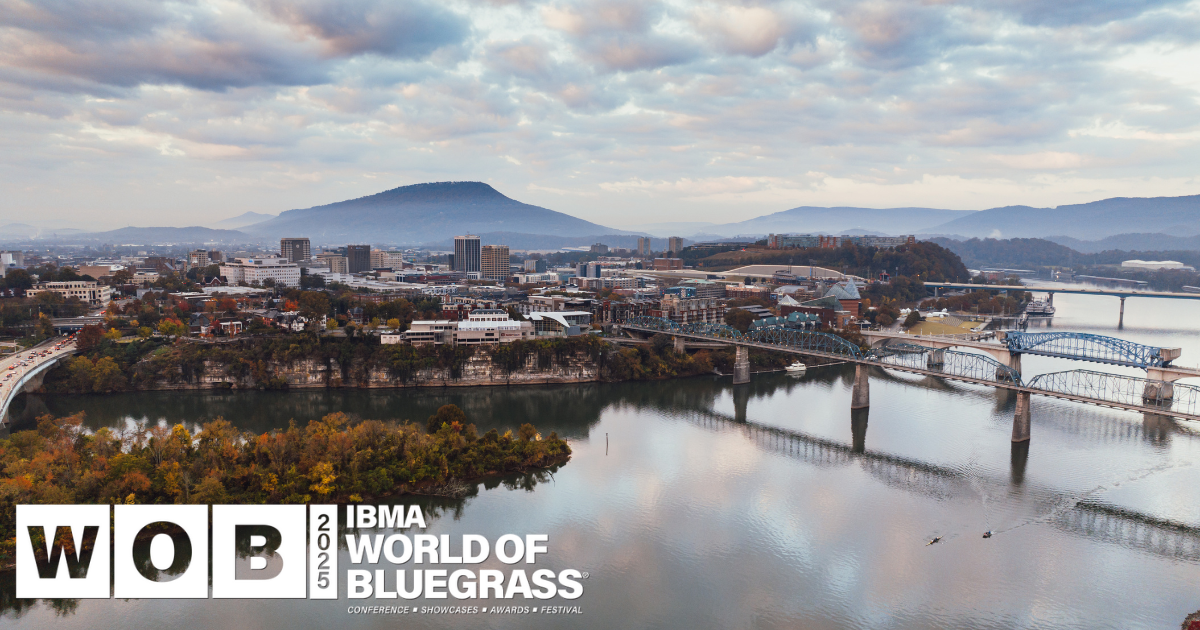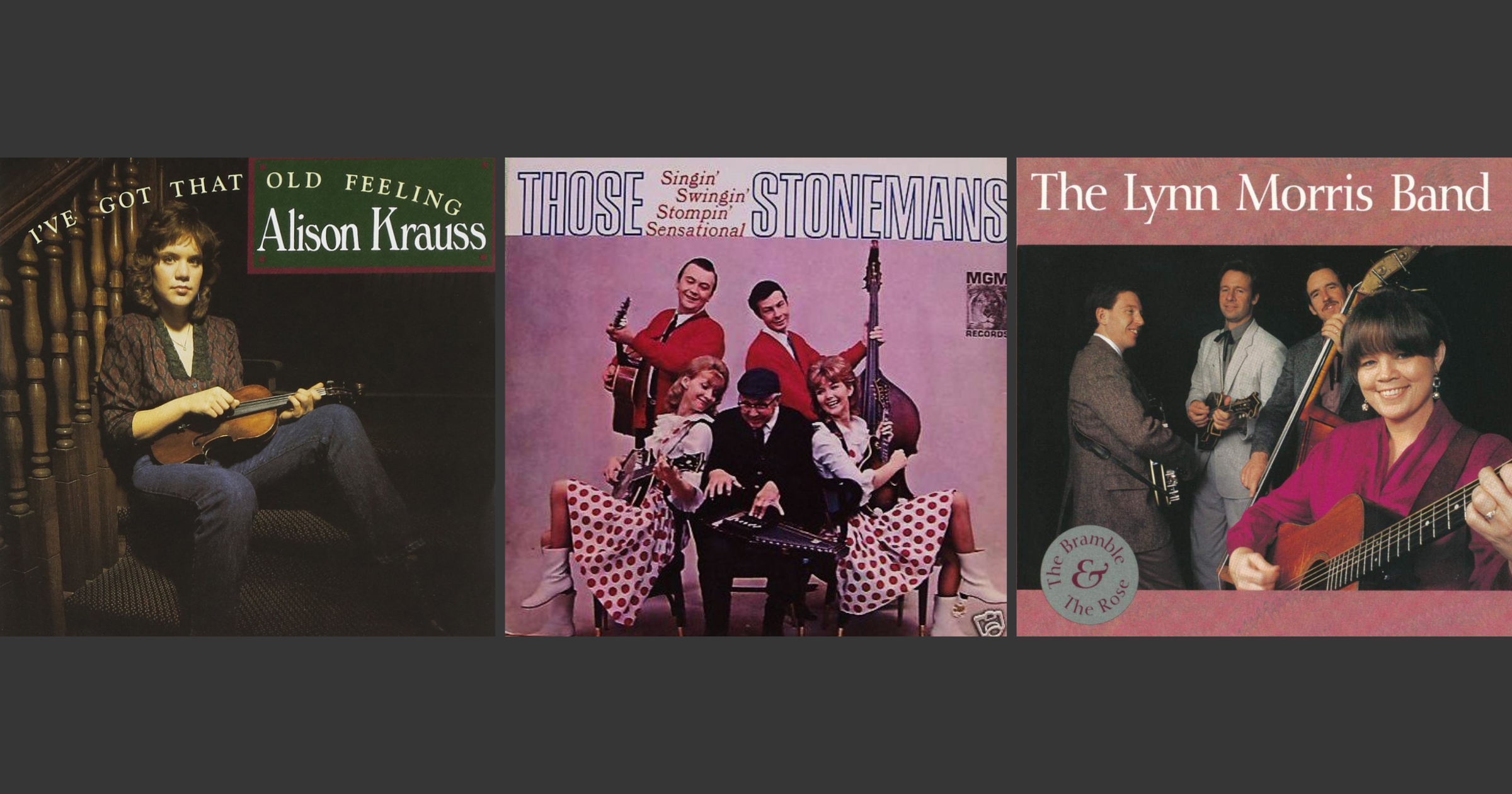After 11 incredibly successful years of partnership with Raleigh, North Carolina, the International Bluegrass Music Association will holds its World of Bluegrass business conference and Bluegrass Live! festival for the first time in Chattanooga, Tennessee, this week. From September 16 to 20 the biggest week in bluegrass will return to Tennessee, this time nestled between the Tennessee River and the mountains, foothills, and ridgetops surrounding this lovely city rich in art, music, food, and culture. Chattanooga has a long history with bluegrass, old-time, and hillbilly music of all strains, so it’s sure to be a perfect home for World of Bluegrass.
As we like to do each year going into the week of events, music, and jamming we all colloquially refer to as “IBMA,” below you’ll find our preview of World of Bluegrass, Bluegrass Live!, the IBMA Bluegrass Music Awards, and the move to Chattanooga. You’ll find information on the festival lineup, official showcase artists playing the Bluegrass Ramble, the layout of the festival and conference footprint, and more. Plus, we’ll have a few tips and tricks for local attractions and must-do/must-see activities while you’re in the River City.
Not able to attend IBMA World of Bluegrass this year? Never fear! Select events and programs from the packed-full conference slate will be livestreamed. You can find info on how to tune in – and what you’ll be able to see – below.
We hope that we’ll see you in Chattanooga this week for IBMA World of Bluegrass!
The Footprint

Don’t forget that the convention center itself is also a Bluegrass Ramble venue! The other handful of Bluegrass Ramble venues are just a couple of blocks away to the south. Plus, the five stages for the weekend festival, Bluegrass Live!, are just around the corner from the convention center, too, where the exhibit hall, workshop stage, and international stage will all be hoppin’ with activity.
Put on your explorer hat and your favorite step-tracking device, we’ve got ground to cover!
What To Do
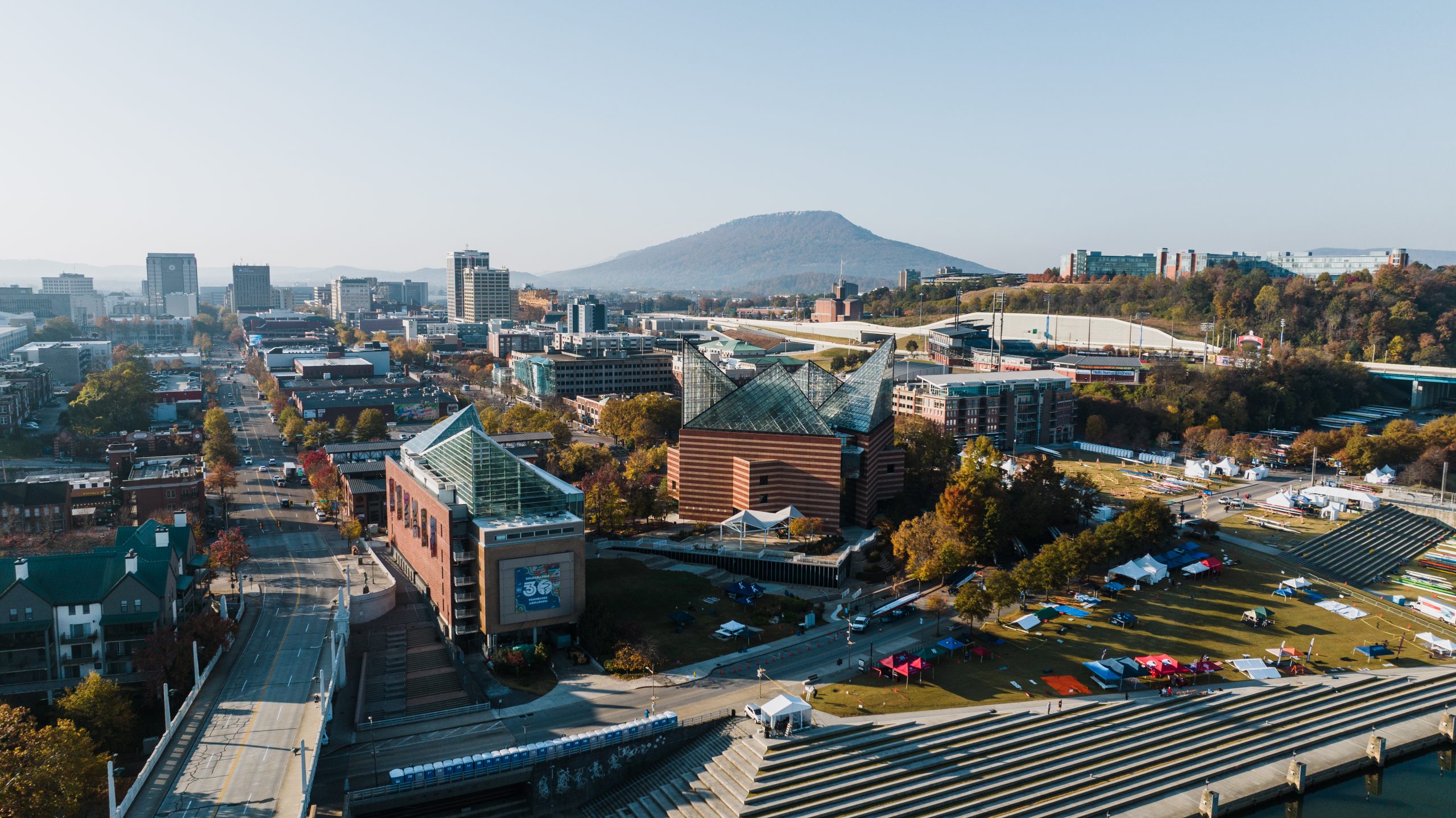
While in Chattanooga, you simply must take advantage of the many first-rate and world-class attractions that stud the city like jewels downtown, on the outskirts, and on the mountaintops overlooking the city and Tennessee River. The Tennessee Aquarium, situated along the riverbanks just a handful of blocks from the conference and festival, is a beloved and award-winning non-profit institution that perfectly showcases the aquatic ecosystems of Appalachia, Tennessee, and the world. Their work through the Tennessee Aquarium Conservation Institute directly benefits the habitats you can see just outside their doors – that kind of local impact is something special. From sturgeon and hellbenders that call the waters around Chattanooga home to oceanic species of fish and jellyfish to exotic birds and reptiles, the Tennessee Aquarium is certainly worth a visit while you’re enjoying a week full of bluegrass.
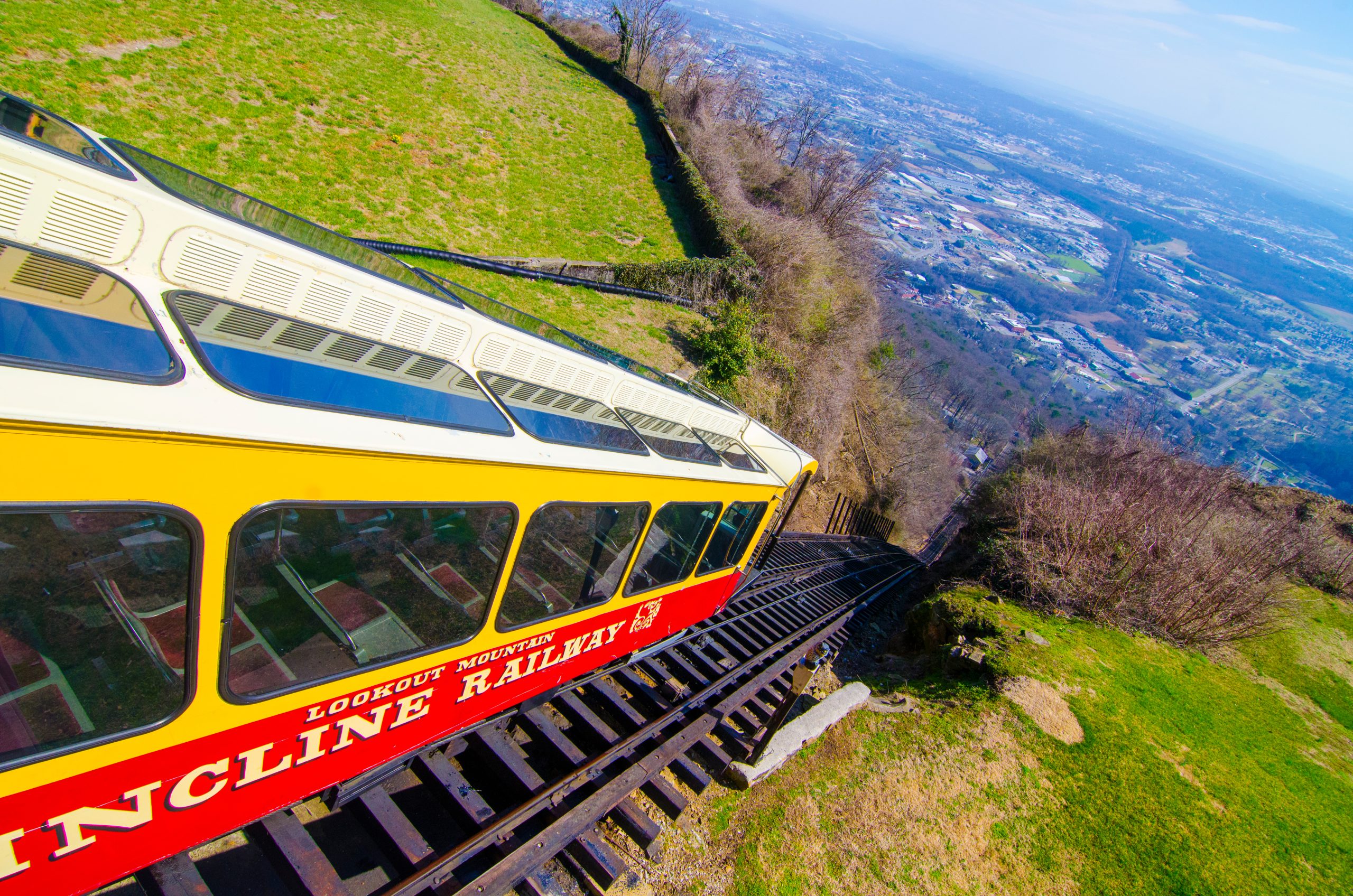
There are far too many amazing Chattanooga-area attractions to list here, but your shortlist for off-site, non-bluegrass activities for the week of World of Bluegrass certainly ought to include Lookout Mountain (especially the Lookout Mountain Incline Railway), Ruby Falls, Rock City, the Creative Discovery Museum, the Hunter Museum of American Art, the Chattanooga Choo Choo Historic District, and many, many more.
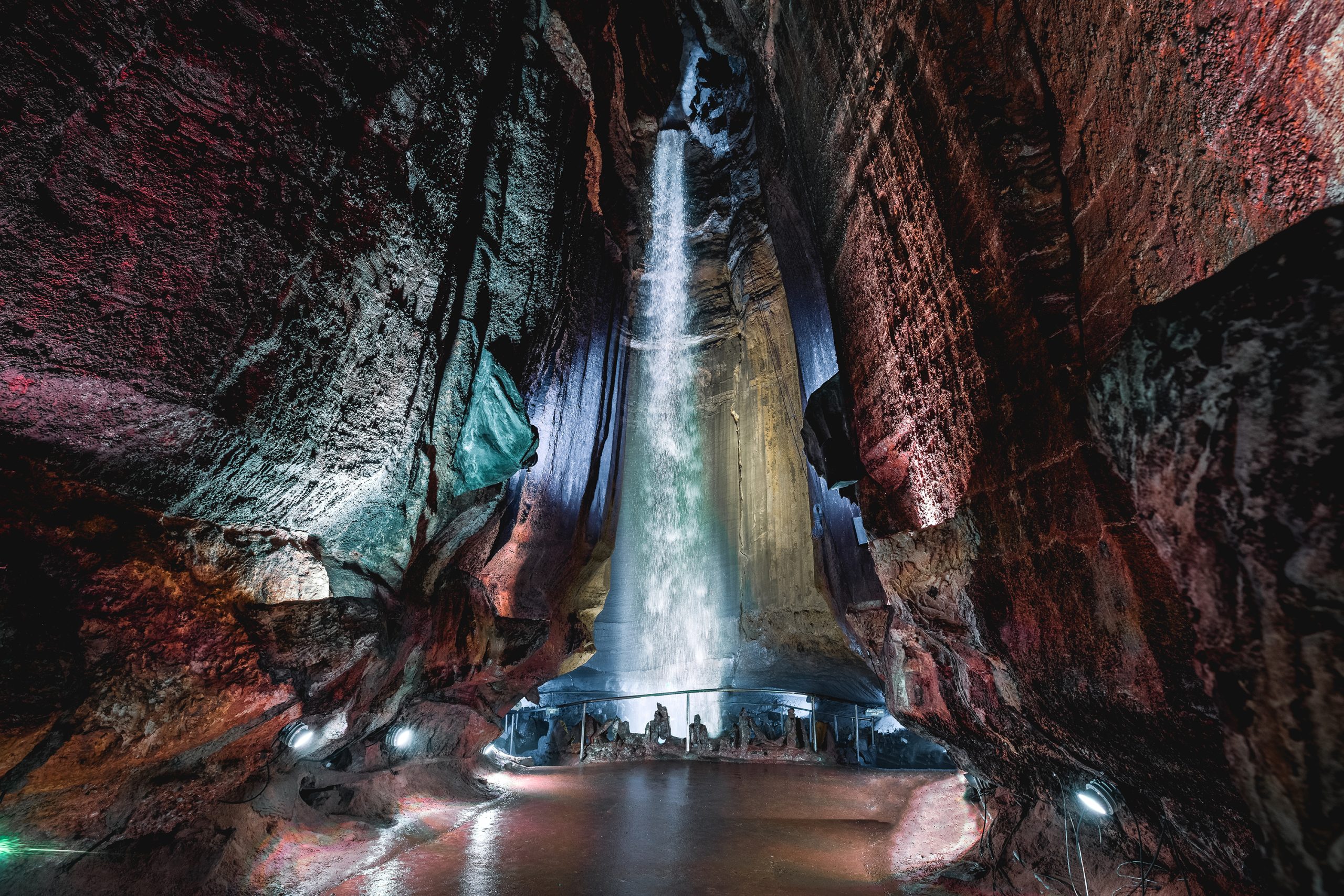
World of Bluegrass

The full schedule for the conference – with panels, showcases, luncheons, awards presentations, and much more – can be found here, so you can sketch out your priorities and must-sees.
A few highlights and standouts we see on the schedule that might inspire you: Jim Lauderdale himself leads Tai Chi each day, so you can start your day connecting with your body and warming yourself up after all-night jamming. On Tuesday, learn about ReString Appalachia, a non-profit program helping put instruments back in the hands of victims of Hurricane Helene. Plus, don’t miss the ever-popular Gig Fair that afternoon, too.
We’re especially excited for the keynote address on Tuesday evening, as our own podcast host and CBC broadcaster Tom Power interviews Billy Strings, with a performance by Junior Sisk to kick off the event. We’re excited to bring you the keynote conversation in the near future as a bonus episode of Toy Heart with Tom Power.
On Wednesday, up-and-comers in the IBMA scene will be honored at the Momentum Awards Luncheon, as well as mentors and industry players. It’s always an exciting and energetic event that celebrates talent, skill, and effort at all levels in bluegrass. Elsewhere in the afternoon, archivist, historian, and musician Jen Larson will dive into the legacy and impact of Bluegrass Hall of Famer Hazel Dickens with her presentation titled “Hazel Dickens, A Bluegrass Life and Legacy at 100.”
There will be town hall meetings throughout the week, as well, where IBMA members can voice their feedback, ideas, and concerns and take an active role in the organization’s future. On Wednesday, the DEI Town Hall will be held at 4:20 p.m. and on Thursday the general IBMA Town Hall will be held at 9 a.m.
Of course, Thursday is chocked full of great programming, too, but we’d be remiss if we did not point out Dom Flemons’ panel, “Rooted Rhythms: African American Contributions to Bluegrass Music.” The first panel of its sort at IBMA, there’s plenty to be learned about the true multi-ethnic origins of bluegrass at this presentation. Don’t miss the Industry Awards Luncheon, the IBMA Songwriter Showcase, and the Women’s Council Meeting on Thursday, too. And, of course, the conference all culminates Thursday night with the IBMA Bluegrass Music Awards show, held just up the road at the Soldiers and Sailors Memorial Auditorium. Hosted this year by Steve Martin and Alison Brown, it promises to be an exciting and engaging celebration of bluegrass music and its makers yet again.
There’s so much more going on throughout the conference, so don’t forget to dive into the full schedule so you don’t miss a thing.
The Bluegrass Ramble
Now, how about some music!? On Tuesday, Wednesday, and Thursday, IBMA Official Showcasing artists and bands will descend on Chattanooga for the Bluegrass Ramble, a series of performances held around official conference venues that will highlight the depth and breadth of the bluegrass scene while spotlighting artists and musicians with new albums, new shows, and new opportunities for bookers, promoters, industry professionals – and fans, of course!
Check out the full lineup of Bluegrass Ramble artists below, but here are a few we’re excited to catch while we’re in Chattanooga: fiddler and dancer Hillary Klug, who recently toured with Cirque du Soleil’s country show, Songblazers (watch above). There’s certainly a reason she’s amassed thousands and thousands of followers online. If you haven’t caught her electric and joyful show before, now is the time.
Some of the best bluegrass being made today is actually old-time, so we’re glad to see plenty of old-time, hillbilly, and mountain music represented throughout the week of World of Bluegrass and on Bluegrass Live! – we’re especially excited to catch showcases by George Jackson & Brad Kolodner.
Mountain Grass Unit are all the rage these days and if you haven’t yet had the chance to catch them live, don’t let your Bluegrass Ramble opportunities slip by. The cutting edge of jamgrass’s second (or third?) generation, these are shredders who can and will transport you beyond the bluegrass veil and into new horizons. These guys are going places and Chattanooga is just one stop on their journey to the stratosphere.
And what about the future of bluegrass? Oh yes, it’s in good hands, as nearly everyone declares when they encounter the picking and singing of young Wyatt Ellis and his band. Maybe “prodigy” is a tired description, but it’s certainly accurate in this case. We’ve covered Wyatt quite a bit over the years and always enjoy watching him grow, mature, and find himself in his music and picking style.
There are many more acts you won’t want to miss during the Bluegrass Ramble, of course! Here’s the full list of showcasing artists, duos, musicians, and bands at this year’s World of Bluegrass: Backline, Burnett Sisters Band, Caroline Owens & New Company, Darin & Brooke Aldridge, Foggy Mountain Spaceship, George Jackson & Brad Kolodner, Greenwood Rye, Hillary Klug, Jackson Hollow, Mark Schatz & Bryan McDowell, Mason Via, Michael Prewitt & CrunchGrass Supreme, Mike Mitchell Band, Mountain Grass Unit, Remedy Tree, Seth Mulder & Midnight Run, Special Consensus, The Faux Paws, The Foreign Landers, The Sentimental Gentlemen, The Sullivan Sisters, The Tennessee Bluegrass Band, The Unfaithful Servants, Under the Rocks, Veranda, Vickie Vaughn, and Wyatt Ellis.
How To Livestream
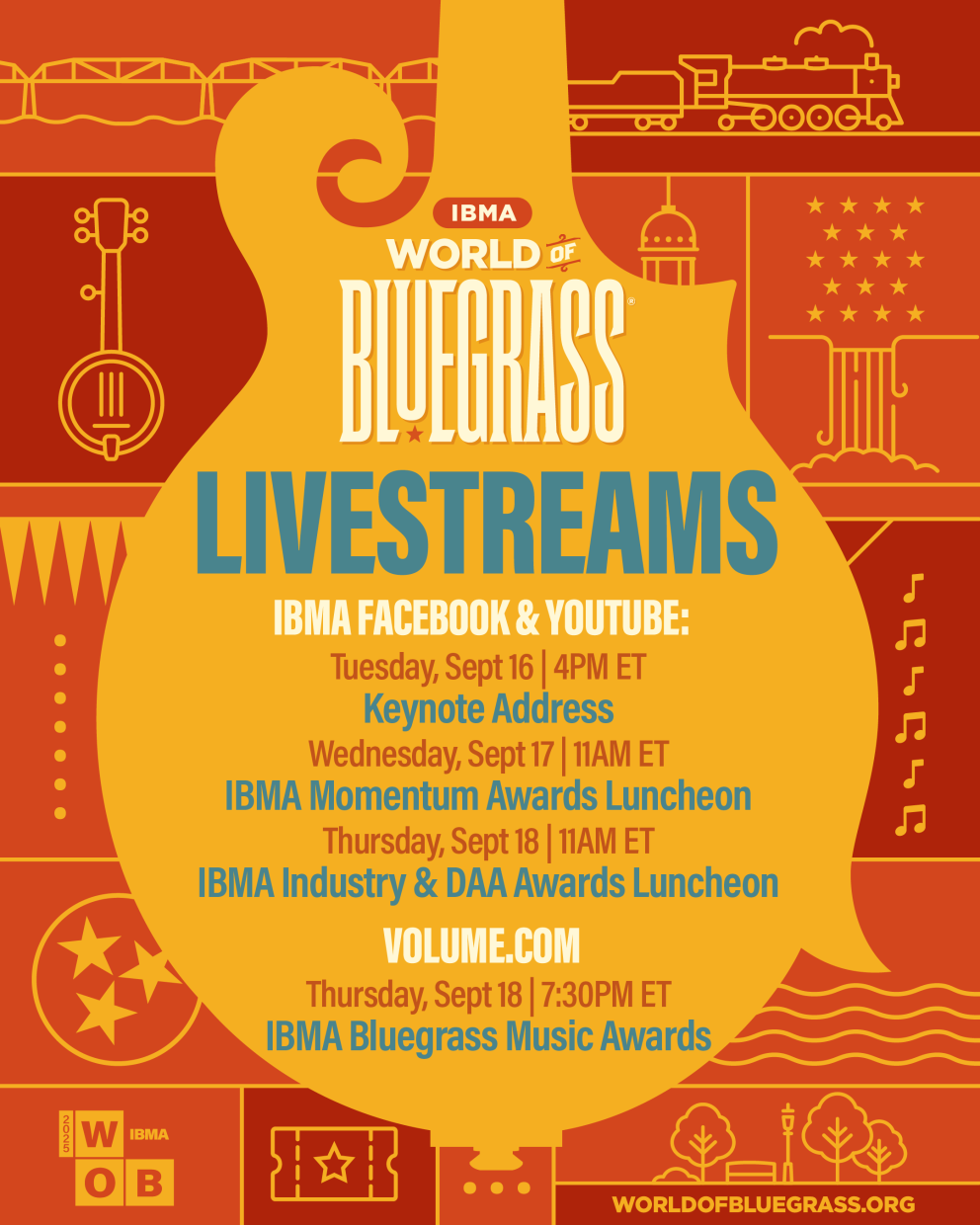
The IBMA Bluegrass Music Awards, one of the most exciting nights of the year in bluegrass, will be carried exclusively by Volume.com. But don’t worry, livestream tickets are free! Tune in for once-in-a-lifetime performances, Hall of Fame inductions, and all of your favorite bands and instrumentalists taking home awards – as voted on by their peers and colleagues!
These livestreams are a great way to participate from afar while you plan your journey to join us in Chattanooga next year.
Bluegrass Live!
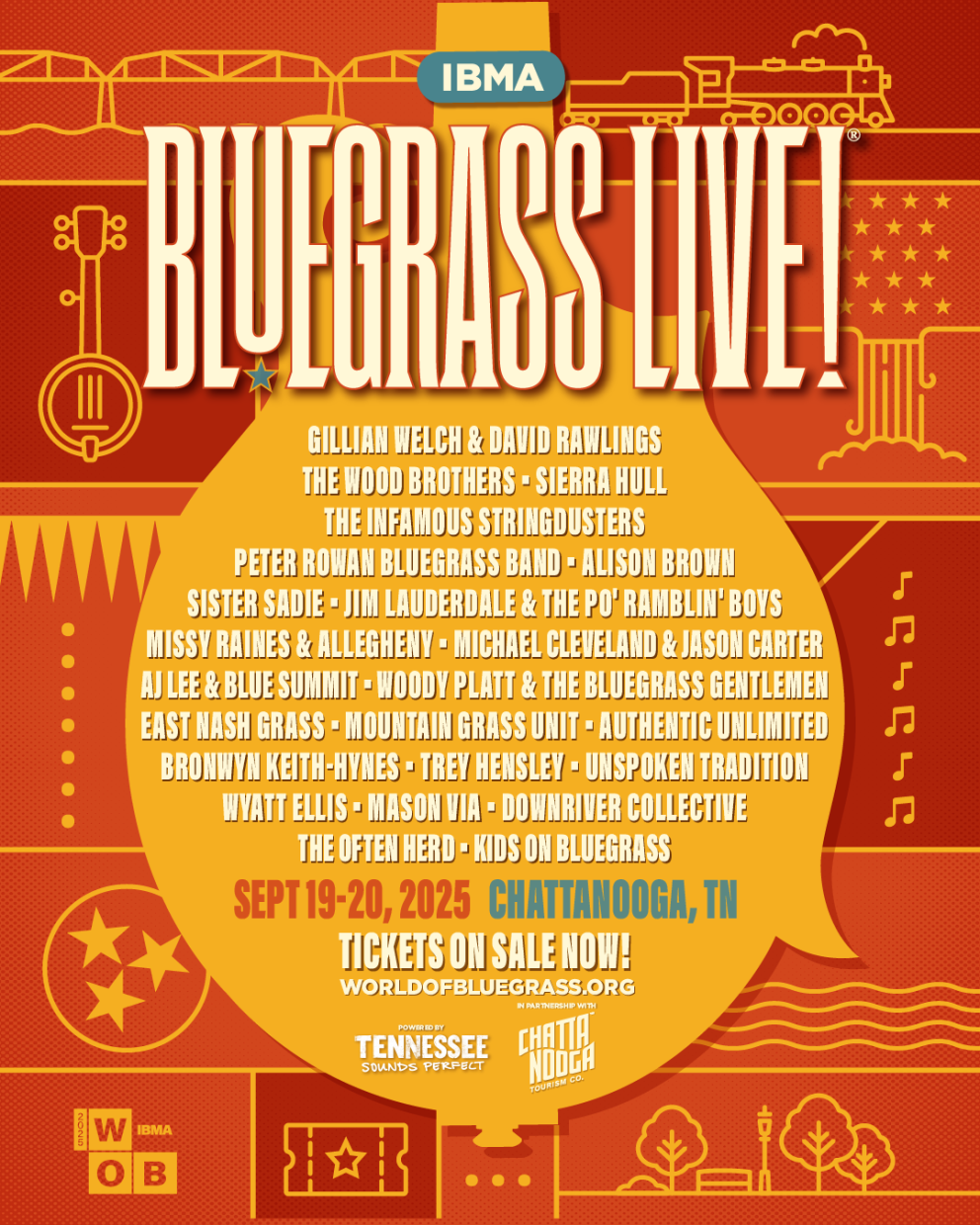
Overwhelmed by your options here, too? We don’t blame you! There’s so much you won’t want to miss, so here’s the full schedule for IBMA Bluegrass Live! to help make your plans:
Tennessee Sounds Perfect Stage, located in Miller Park – Friday, September 19
2:05PM – 3:20PM Alison Brown
4:30PM – 5:45PM Jim Lauderdale & The Po’ Ramblin’ Boys
7PM – 8:15PM Sierra Hull
8:45PM – 10:15PM The Wood Brothers
Saturday, September 20
2:05PM – 3:20PM AJ Lee & Blue Summit
4:30PM – 5:45PM Michael Cleveland & Jason Carter
7PM – 8:15PM The Infamous Stringdusters
8:45PM – 10:15PM Gillian Welch & David Rawlings
Pinnacle Financial Partners Stage, located in Miller Plaza – Friday, September 19
1PM – 2PM DownRiver Collective
3:25PM – 4:25PM Mason Via
5:50PM – 6:50PM Trey Hensley
Saturday, September 20
1PM – 2PM The Often Herd
3:25PM – 4:25PM Wyatt Ellis
5:50PM – 6:50PM Mountain Grass Unit
Visit Chattanooga Stage, located in Patten Square – Friday, Saturday 19
1PM – 2PM Kids on Bluegrass
2:30PM – 3:30PM Peter Rowan Bluegrass Band
4PM – 5PM Missy Raines & Allegheny
5:30PM – 6:30PM Woody Platt & The Bluegrass Gentlemen
7:15PM – 8:45PM East Nash Grass
Saturday, Saturday 20
1PM – 2PM Kids on Bluegrass
2:30PM – 3:30PM Authentic Unlimited
4PM – 5PM Unspoken Tradition
5:30PM – 6:30PM Bronwyn Keith-Hynes
7:15PM – 8:45PM Sister Sadie
Don’t have your tickets yet? It’s not too late! Click here to purchase single and two-day tickets to Bluegrass Live! The festival will also include free programming on several stages, too, so there are options to enjoy for fans and audience members at all levels.
In fact, it’s not too late to line up admission for any part of World of Bluegrass, from the conference to the Bluegrass Ramble to the awards show to Bluegrass Live! You do want to join us in Chattanooga for the first year in this brand new beautiful host city, right? Get all the info on World of Bluegrass here and make your plans to join us – the fun gets officially going tomorrow, September 16, in the Scenic City.
Photos courtesy of Chattanooga Tourism Co., photo credits as marked. Lead image: Downtown Chattanooga by Kelley Lacey.
Graphics and logos courtesy of the International Bluegrass Music Association.
